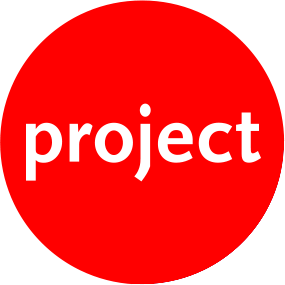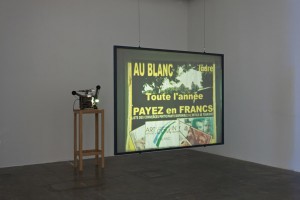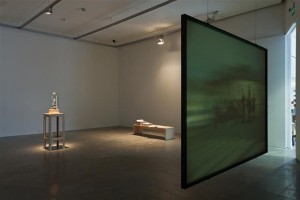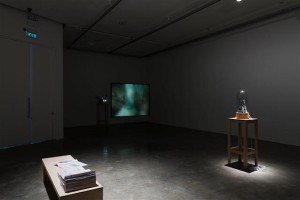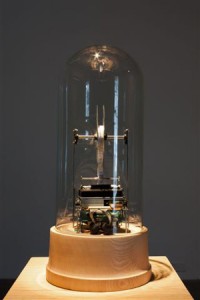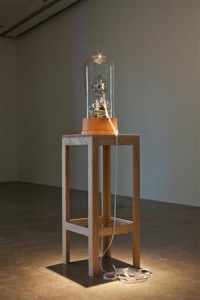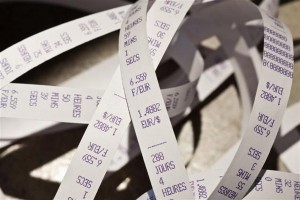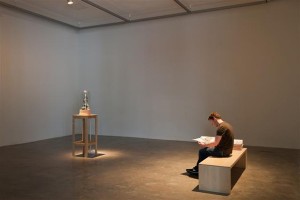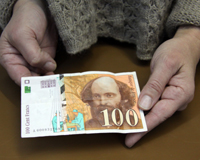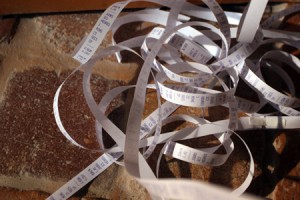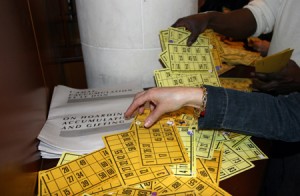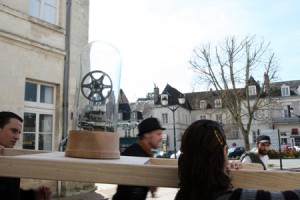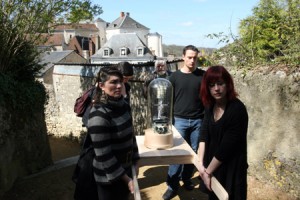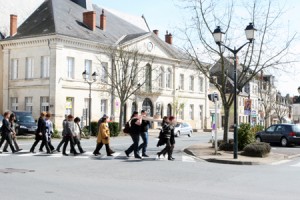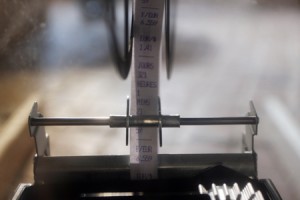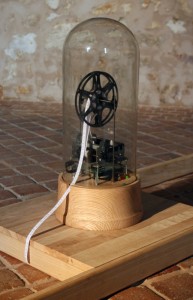Project Arts Centre presents
Sarah Browne
Curated by Tessa Giblin
Sarah Browne’s new film installation Second Burial at Le Blanc focuses on the small French town of Le Blanc, where a coalition of local artisans and shopkeepers have created one of the last refuges for indigenous currencies. Le Blanc is still accepting the franc as payment for goods and services in certain shops although it is technically no longer legal tender, and will continue to accept it until 17 February 2012 a deadline imposed by the Banque de France. Produced against a backdrop of extreme economic vulnerability, both internationally and in Ireland, Browne’s project hones in on a community story that becomes the lens through which to examine the depth of emotional investment, and resistance to change, in economic systems. Sarah Browne is part of PROJECT CATALYST, an initiative of Project Arts Centre.
The new film produced by Sarah Browne for her solo exhibition Second Burial at Le Blanc, follows a procession through the streets of a small French town. For the last nine years, and until Friday 17 February 2012, the Central Bank of France will continue to exchange francs for euro. In recent years traders and artisans of Le Blanc have capitalised on the window of opportunity this presents, creating a scheme in which they accept francs in exchange for goods and services, thus increasing their niche potential to attract visitors and tourists to the town. The procession – in which local residents carry a glass domed ‘ticker-tape countdown clock’ from the new part of the town to the old – is a commemorative event, marking the waning days of the franc, and the changed economic circumstances which now plague the euro.
In a newspaper called On Hoarding, Accumulation, and Gifting made by Sarah Browne and distributed to local residents prior to the procession, a statement from German Chancellor Angela Merkel surmises: ‘The current crisis facing the euro is the biggest test Europe has faced in decades. It is an existential test and it must be overcome… if the euro fails, then Europe fails.’The ticker-tape countdown clock at the centre of both the film and the exhibition is a live, wifi-enabled machine. This is based on the original stock ticker machines that produced endless snakes of paper strips, as stock market data from all over the world was transmitted via telegraph to trading floors and information boards. This by-product of the financial markets found a secondary use for the first time in 1886 when streams of ticker tape were spontaneously flung from high-rise windows in celebration of the parade that welcomed the Statue of Liberty to New York, gifted by France. With the idea of a ‘ticker-tape parade’ now commonly recognised throughout the world, Sarah Browne combines concepts of financial trade alongside many mixed messages of technological development. In her film the ticker tape machine is carried on a primitive stretcher without wheels, the film itself is shot and screened on increasingly archaic 16mm celluloid, and all are in focus around the second burial of an almost-dead currency. For some, the processional event, the film, the ticker-tape countdown clock and the contextualising newspaper are made by the artist as a monument-in-process to the entangled ideological and historical moment that Le Blanc has come to represent, and for others signify the simple practicality of maintaining a small local economy.
In his book Stone Age Economics, quoted in On Hoarding, Accumulation, and Gifting, Marshall Sahlin states, ‘to understand our [western] economy requires the same kind of anthropological sensibility we bring to the study of others.’ For Browne, this call for an ethnographic approach to the interrogation of developed countries’ economic entanglement is echoed in the performance made in Le Blanc. The artist has created a ritual – a procession that is characterised by its present context, and informed by other cultural traditions. In parts of Madagascar, we read, the deceased are at times excavated, re-shrouded, paraded and re-buried. The process honours the dead and updates their spirit about developments in the village since their passing. The artist has built a sculpture that produces a memorial: it is both marking a finite period of decline by printing the countdown to the 17 February next year, and also the catalyst for making a film which will outlast the context of its time and provide a window into the past.Inevitably, this exhibition in Dublin – a stone’s throw from the Central Bank of Ireland and made by an Irish artist – will be identified with the crisis of the Irish economy in 2010, Portugal in 2011, with the possibility of future loan defaults underscoring the insecurity of EU member states’ relationships to their common currency, the euro. The International Monetary Fund is also a spectre in the background to this story, France being the first nation to accept a loan from the IMF in 1947, and Ireland the most recent. The gallery for this exhibition period is a physical space to encounter ideas about the increasingly abstract financial structures that are our future as much as the material souvenirs of our past.
List of works: Second Burial at Le Blanc, 2011 Looped 16mm film projection, colour, silent, 8′ 18” Ticker-tape countdown clock, customised printer with glass dome and ash base, height 66cm, Ø 30cm, length of paper variable (counting down the hours, minutes and seconds to the last francs to be exchanged on 17 February 2012, with live currency feed via wireless internet)On Hoarding, Accumulation, and Gifting, 2011 Newspaper (French & English), distributed in Le Blanc and Dublin, edition 1500.
With thanks to: Art’Com’In Le Blanc, Mairie du Blanc, Ecomusée du Brenne, La Maison des Amis du Blanc, Sylvie Auteau, Hélène Guillemot, Helen Carey, Romilly Masters and Jeananne McGovern.
More information about Sarah and her work is available on her website
Credits
Fabrication and Software Development: Jack Phelan
Interpreter / Production Assistant: Julien Dorgere
Director of Photography: Lukas Demgenski
Graphic Design: Peter Maybury
Additional Translation: Susan Thomson
Biographies
Sarah Browne (b.1981) is an artist based in Ireland. Her practice includes exhibitions, public projects, publishing and critical writing. Her research-based practice implicitly addresses ‘the economy’ as the dominant metaphor for contemporary social and political relations. She is concerned with the creation or documentation of intentional economies and temporary communities, typically small-scale systems influenced by emotional affects. An interest in forms of non-market exchange such as gifting, subsistence, subsidies and poaching leads to the creation of particular bespoke objects for circulation and use to map existing but sometimes hidden social relations. This work is typically domestic in character, using technologies such as knitting, flower-pressing, letter-writing, carpet-knotting and film-making, and is often carried out with the participation of a ‘community’ where it is based, or creates a fictional or temporary ‘community’ for itself.Browne has participated in residencies and artist exchanges in Finland, Thailand, Japan and the UK and is currently resident at Firestation Artist Studios, Dublin. Recent exhibitions include Minimalism and Applied II, Daimler Contemporary, Berlin, and Unto This Last, Raven Row, London (both 2010). In 2009 she co-represented Ireland at the 53rd Venice Biennale.
Funding
Sarah Browne has been supported by a Project Award from the Arts Council. The new commission by Project Arts Centre is being co-produced in partnership with Ikon Gallery, Birmingham, and Contemporary Art Gallery, Vancouver, and will include a catalogue to be launched in 2012.
Disclaimer
Closed Sundays & Bank Holidays
